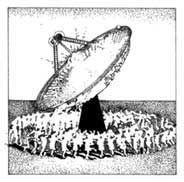MTAA-RR » curatorial » lo-fi baroque:
Lo-Fi Baroque
1998, Thread Waxing Space, NYC, NY
participating artists
Peggy Ahwesh, Barry Barlett, Thereas Brezany, Gregory Green, Chris Hanson and Hendrika Sonnenberg, Rachel Harrison, James Hyde, Cary S. Leibowitz / Candyass, Cotter Luppi, Vik Muniz, Amy O’Neill, Elizabeth Zawada, Thomas Zummer
film-night artists
Peggy Ahwesh, Mike Ballou, Brian Dewan, Michael Gitlin, Chris Hanson and Hendrika Sonnenburg, Rafael Montanez Ortiz, Julie Murray, Lee Ranaldo, Jimmy Raskin, Leah Singer, Nozomu Suwa, Leslie Thornton, Elaine Tin Nyo, Kevin Walsh and Jeffrey Reiman
Catalouge Project: “Static Fragments Afterimages”
 7” x 7”, 32 pages. (Available for 10.00 USD, contact M.River to obtain a copy.) By Thomas Zummer, with disographies by Michael Sarff and Carol Stakenas.
7” x 7”, 32 pages. (Available for 10.00 USD, contact M.River to obtain a copy.) By Thomas Zummer, with disographies by Michael Sarff and Carol Stakenas.
Imagine holding a large and almost round pearl in your hand. Peering into its translucent surface, one may attempt to view one’s refection. The distortion of your view within the surface’s flaws may be a point where understanding and meaning occurs.

Lo - Fi Baroque, or The City is an Imperfect Pearl
The title of the exhibition is a ready made term that cuts and pastes a 20th century phenomenon in indie rock music with one of the most the notoriously excessive periods in Western Art. A place to begin the understanding of this idea is within its parts. The term Lo-Fi (Fi as in Fidelity) originally references a genre of popular music that is made with instruments and recording techniques that eschew cutting edge technologies in favor of simpler “out dated” machines. Bands such as Guided By Voices, Scrawl, and Sonic Youth choose to work in a way that adds an identifiable aesthetic into their music and how their music is heard. Steve Terell describes Lo-Fi bands as follows:
What these groups have in common, besides their roots in the punk underground, is an underlying humor in their music (even when the jokes are not obvious), a developed sense of the surreal, and a willingness to take a musical idea to an extreme. They aren’t afraid of noise, screech, and silly sounds emitting from their guitars.The counter balance to the pop ascetic of Lo - Fi lies within the excess of the Baroque. For 200 years in Europe (c. 1550 - 1750), Baroque (from the Portuguese word meaning imperfect pearl) and its ill mannered child Rococo, dominated the landscape of art and architecture. Baroque art moved away from the logic of the straight line, simple melodies, and the unordered towards a moment in time when complexity reigned. Whether it was the body in motion, a fold of cloth, or the light falling across an architectural altarpiece, it seems their was no limit to the visual and mental experience in art.

Fuse theses two terms together and the results are not only the sums of seemly contradictory parts. This hybrid phrase can now be used to delineate relationships among the exhibited work. Lo -Fi Baroque, in regards to the art of Liz Zawada or James Hyde, may be used to navigate the artists play between sculpture and painting, a common immediacy of the consecution or their methods for enfolding material into meaning. Similarly, in the pirate radio broadcast of Gregory Green or the clipped Life Magazine images of Vik Muniz, this phrase may highlight their shared act of creating turbulence within the realm of public domain. In all cases, the relationships pushed by Lo -Fi Baroque occur not only within the formal play of the art but also in the artists’ stance in regard to meaning and the external world.

As Lo - Fi Baroque generates a commonality between the varied artist work, it is also points outwards to the social and physical landscape of the city. It is within the work of Thomas Zummer that this movement outwards is played out. Using the format of a detective genera comic, Zummer’s document of the show allows a notion of Lo - Fi Baroque to spill from the gallery and into the city or vis versa. The comic, which includes information by and / or about the artist and artworks of the show, is a type of map for the viewer to enter the various levels and relations of the show.

MTAA-RR » curatorial » lo-fi baroque